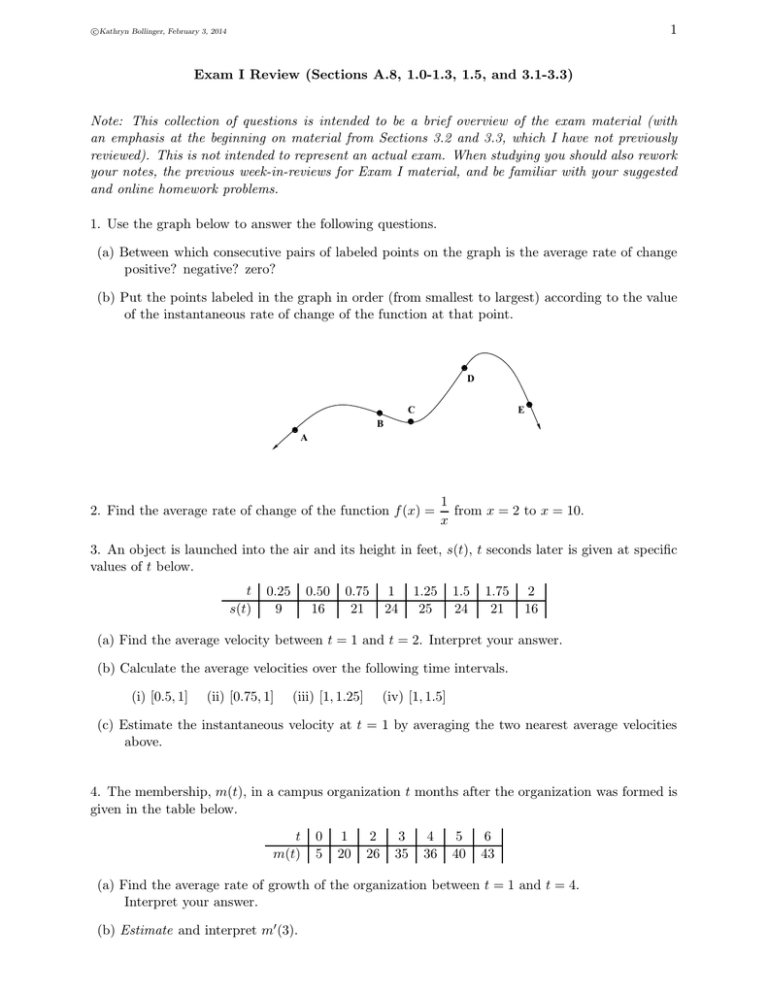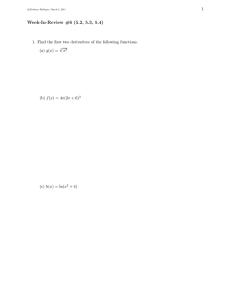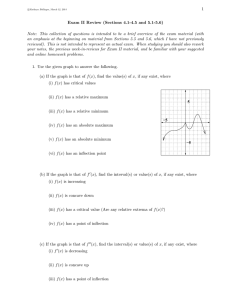Document 10412594
advertisement

1 c Kathryn Bollinger, February 3, 2014 Exam I Review (Sections A.8, 1.0-1.3, 1.5, and 3.1-3.3) Note: This collection of questions is intended to be a brief overview of the exam material (with an emphasis at the beginning on material from Sections 3.2 and 3.3, which I have not previously reviewed). This is not intended to represent an actual exam. When studying you should also rework your notes, the previous week-in-reviews for Exam I material, and be familiar with your suggested and online homework problems. 1. Use the graph below to answer the following questions. (a) Between which consecutive pairs of labeled points on the graph is the average rate of change positive? negative? zero? (b) Put the points labeled in the graph in order (from smallest to largest) according to the value of the instantaneous rate of change of the function at that point. 1 0 0 1 D 1 0 0 1 B 1 0 1 0 0 1 0 E1 C 1 0 0 1 A 2. Find the average rate of change of the function f (x) = 1 from x = 2 to x = 10. x 3. An object is launched into the air and its height in feet, s(t), t seconds later is given at specific values of t below. t s(t) 0.25 9 0.50 16 0.75 21 1 24 1.25 25 1.5 24 1.75 21 2 16 (a) Find the average velocity between t = 1 and t = 2. Interpret your answer. (b) Calculate the average velocities over the following time intervals. (i) [0.5, 1] (ii) [0.75, 1] (iii) [1, 1.25] (iv) [1, 1.5] (c) Estimate the instantaneous velocity at t = 1 by averaging the two nearest average velocities above. 4. The membership, m(t), in a campus organization t months after the organization was formed is given in the table below. t m(t) 0 5 1 20 2 26 3 35 4 36 5 40 6 43 (a) Find the average rate of growth of the organization between t = 1 and t = 4. Interpret your answer. (b) Estimate and interpret m′ (3). 2 c Kathryn Bollinger, February 3, 2014 5. Given f (x) = 2x2 + 4, find (a) the average rate of change of f (x) when x changes from 0 to 2. (b) the instantaneous rate of change of f (x) at x = 0. 6. Use the limit definition of derivative to find the derivatives of the following functions. Use the derivatives you find to answer the subsequent questions. (a) f (x) = 2x2 − x; Find where the graph of f (x) will have a horizontal tangent line. x ; Find the equation of the line tangent to g(x) at x = 1. x−2 √ (c) k(x) = x − 3; Find the domain of k′ (x). (b) g(x) = 7. Write the equation of the line tangent to y = f (x) at x = 8 if f ′ (8) = −7 and f (8) = 2. 8. 1 0 0 1 7 f(x) 1 0 0 1 1 0 0 1 −5 5 1 0 1 0 0 1 −7 (a) State the domain of f (x). (b) Where is f (x) discontinuous? Justify your answer using the definition of continuity. (c) Where is f (x) not differentiable? Justify your answer. (d) Where is the instantaneous rate of change of f (x) zero? 3 c Kathryn Bollinger, February 3, 2014 9. Use the given graph to answer the questions which follow. g (x) (a) Find lim g(x) x→−1 3 (b) Find lim+ g(x) x→2 (c) Find lim− g(x) x→2 (d) Find lim g(x) -3 x→2 3 (e) Find lim g(x) x→1 (f) Find all values of x where g(x) is discontinuous and state the continuity condition that is violated. -3 (g) Find all values of x where g(x) is not differentiable and give a reason why it is not differentiable. 10. Given the graph of f (x) below, sketch a graph of f ′ (x). 2 2 −2 −2 2 2 −2 −2 4 c Kathryn Bollinger, February 3, 2014 11. KB and Co. produces TVs. It costs KB and Co. a total of $800 to produce 5 TVs. It can sell a total of 5 TVs when they are priced at $250 each and 10 TVs if the price is reduced to $150 per TV. If KB and Co. decides not to produce any TVs, they will still have costs totaling $400. If x represents the number of TVs made or sold, find (a) the linear price-demand function. (b) the linear cost function. (c) the revenue function. (d) the profit function. (e) the break-even point(s) and, therefore, over which intervals KB and Co. will realize a profit gain or loss. (f) the price at which KB and Co. should sell TVs in order to maximize their revenue. (g) the price at which KB and Co. should sell TVs in order to maximize their profits. (h) the average rate of change in profit from x = 1 to x = 4 and interpret. 12. How long will it take before there are only 10 grams of an isotope left, if N (t) = 50 gives the number of grams left after t minutes? 13. Where is f (x) = x−6 x+1 x−3 ,x≤4 ,x>4 discontinuous? 14. Algebraically calculate the following limits. √ x+3 (a) lim x→1 3x 4x3 − x2 x→0 2x2 − x (b) lim (c) lim x→5+ 2|5 − x| x2 − 25 x2 − 4 x→2 x2 − 4x + 4 (d) lim 15. Algebraically solve the following for x. (a) log2 (ln(x + 2)) = log 100 (b) log3 (2x − 4) = 6 + log3 (4x) 16. Find the domain of the following function. √ x+7 x e (x + 2) √ g(x) = 3 x2 − x , x ≤ −4 , −4 < x ≤ 1 log4 (x − 3) , x > 1 t/19 1 2 5 c Kathryn Bollinger, February 3, 2014 17. Starting with the function f (x) = 2x , find a function, g(x), whose graph is obtained from first shifting f (x) left 3 units, then reflecting about the x-axis, and finally shifting down 2 units. 18. Given f (x) = √ x ,x≤1 2x − 3 , 1 < x < 3 , answer the following. −3 ,x>3 (a) Make an accurate graph of f (x). (b) Find f (3), if it exists. (c) Find lim f (x), if it exists. x→1 19. Producers of widgets will not supply any widgets to the marketplace at $5 or less, but will supply an additional 50 widgets for every $4 increase in the price per widget. It is known that the price-demand function for the widgets is p = −1.12x + 65, where x is the number of widgets consumers buy at $p per widget. Find the equilibrium point for the widget market. 20. Which of the following is a rational function? If a function is not rational, explain why not. x2 + 4x − 8 x1/2 e (b) f (x) = x+4 (a) y = 21. How much would you have to invest into an account paying 5.75% annual interest compounded quarterly now in order to have $10,000 in 10 years? What is the effective yield of this account? 22. If the point (2, 3) is on the graph of a one-to-one function, then the point be on the graph of its inverse. will











